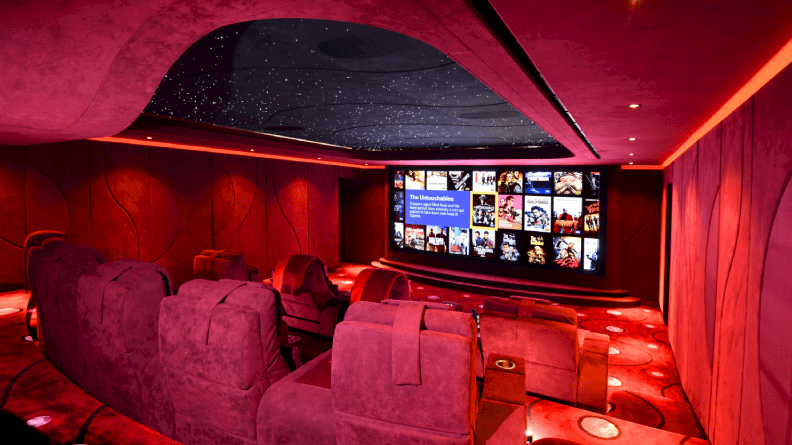
Cyberhomes' "Ruby Cinema" project was from the beginning designed to be a unique house concept and experience for the client. Featuring a Dolby Atmos 11.10.6 system using in-wall Meridian Digital speakers and subwoofers, it is controlled by a Trinnov Altitude32 processor which allowed Cyberhomes to overcome the acoustical challenges inherent to this space and fine-tune what is nothing short of a breathtaking home cinema.
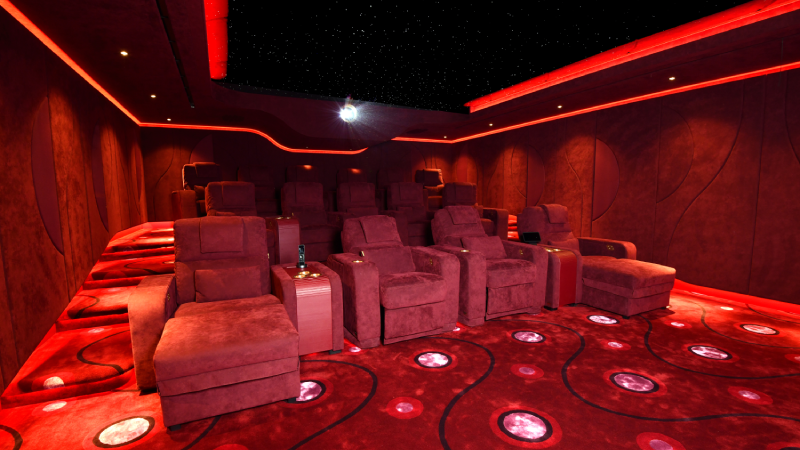
Please give us a bit of your background and company history.
Cyberhomes was founded in 2004 by Ion Smith and Andy Mack, who had formerly worked together on providing broadcast installations for the BBC. Initially, the company's focus was on automation and multiroom projects, which became the basis of its growth. In the last decade, Cyberhomes has specialized in creating customized, high-end cinemas for its clients.
With the help of its in-house team of technical designers, fabricators, lighting and interior design professionals, Cyberhomes has established itself as one of the most experienced in-house fabrication teams in the UK and Europe, with the ability to design and build the entire room, including internal walls, coffer ceilings, tiered cinema seating, lighting and interior design.
Cyberhomes' aim is to offer a very personal cinema experience which reflects the client's personality and their specific ideas, we constantly strive to push the boundaries of room design.
From a technical perspective, every cinema room is carefully calculated, acoustically treated and fully calibrated to ensure optimal sound quality.
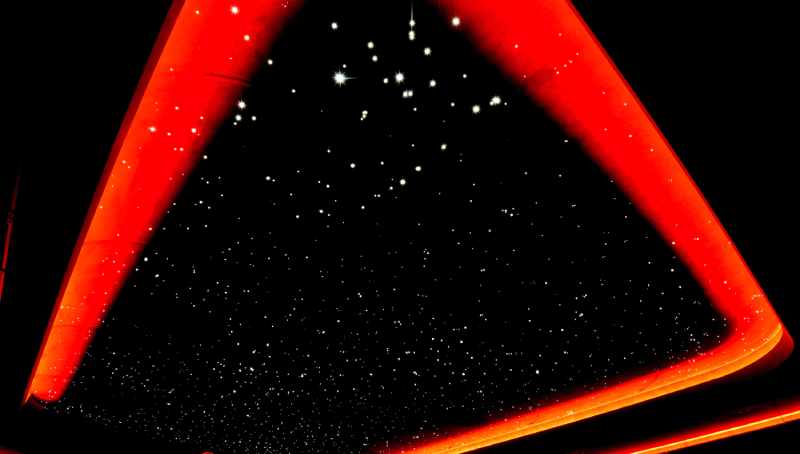
What was the client’s original intent for this project? Did you make changes to its scope during the design process?
The Ruby cinema was a part of a unique house concept and experience, where every room had a different theme with a dose of ‘wow factor!’. The Ruby cinema's interior designer aimed to create a luxurious private movie theater with a distinct style that would seamlessly blend the walls, ceiling, floor, and seating to provide a fully immersive look and experience.
One of the requirements for the room was to have the capacity to accommodate 15 or more people, enabling them to view big sporting events and presentations comfortably. To meet this requirement, the design included three rows of seating, which helped our client's and interior designer's desire for a cinema-like aesthetic.
Our client was a huge fan of movies and music, they wanted a Dolby Atmos multichannel speaker setup that could produce high sound pressure levels delivering clear, dynamic, and bass-heavy audio, but also wanted to ensure that every nuance and emotion from the sound was retained to create a truly immersive experience.
During the design process, we made some additions to the project scope. For instance, we included gaming consoles at the front of the room and upgraded the projector to a larger size. These changes were made as the client became more aware of what could be achieved within the available space. To further improve the experience, we installed Dbox on the front-row and bass shakers on the second row.
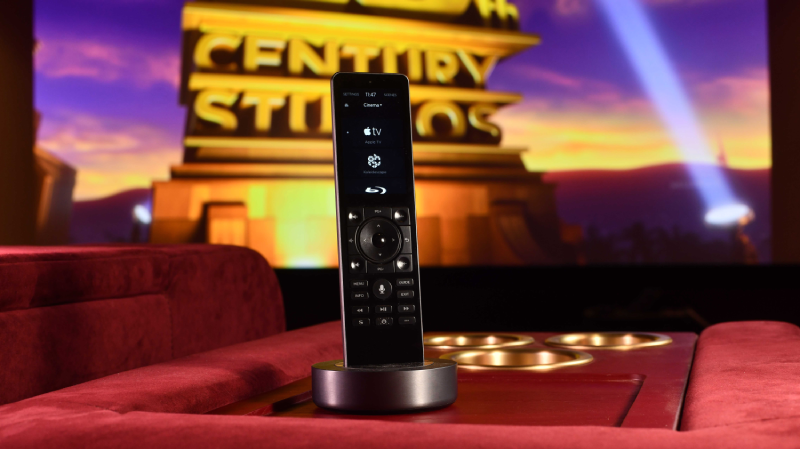
Tell us about the room design and speaker layout.
After conducting an initial analysis of the room to identify any potential design restrictions or issues, we utilised CEDIA, SMPTE, and the Trinnov Speaker layout guidelines to determine the optimal video, audio, and acoustics performance. We took into account factors such as room modes and RT60 value during our analysis.
Following this, we held a discussion with the client and interior designer to determine the best room layout and construction that would achieve the desired look and feel while maintaining the best performance of audio and video. For the 3 tier seating arrangement, we discussed and recommended that the main listening position (MLP) would be the middle seat in the second row, with consideration given to the middle seats in the front row as the client stated that they would be heavily used for gaming. The third seating row had slightly compromised seating positions, so we considered them to be extra functional seating which still offered respectable performance.
After considering the room's dimensions and layout, our preferred speaker layout was a Dolby Atmos 11.10.6 system using in-wall Meridian Digital speakers and subwoofers controlled by the Trinnov processor.
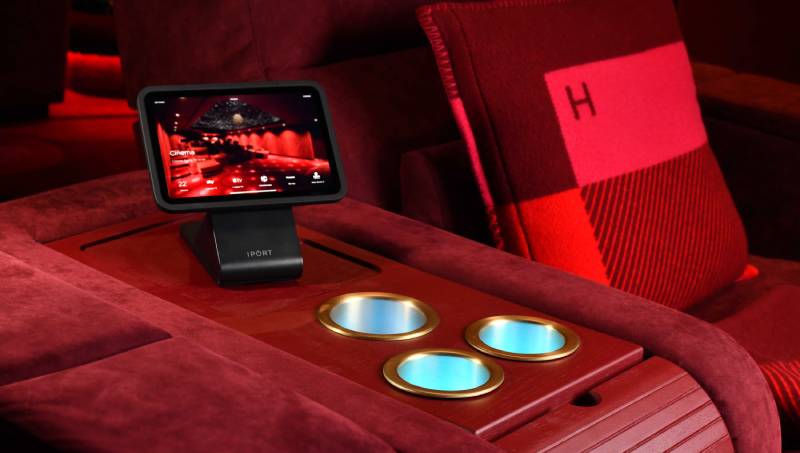
This speaker combination provided plenty of dynamic headroom to allow fine-tuning with the multiple subwoofers, allowing precise distribution of clean controlled bass. The in-wall Meridian speakers also overcame the front wall and side wall depth limitations due to their shallow dimensions. We believe that Trinnov and Meridian together provide exceptional performance with great control of fine-tuning and the final sound of the room.
Design features in the room include a unique projector housing that is climate controlled. The inspiration for this curved projector housing came from a previous cinema room that we designed, and the client loved it. Therefore, they wanted us to create something similar.
The enclosure features custom-made brass eyelets for the lens outlet, using the same brass finish as the customized seating cupholders. Each wall panel was designed with a specific curved aesthetic in mind and was mirrored in other parts of the room, including the fiber-optic ceiling, which was finished in Alcántara to match the walls.
Everything in the room was designed to blend seamlessly, creating a cohesive look and feel.
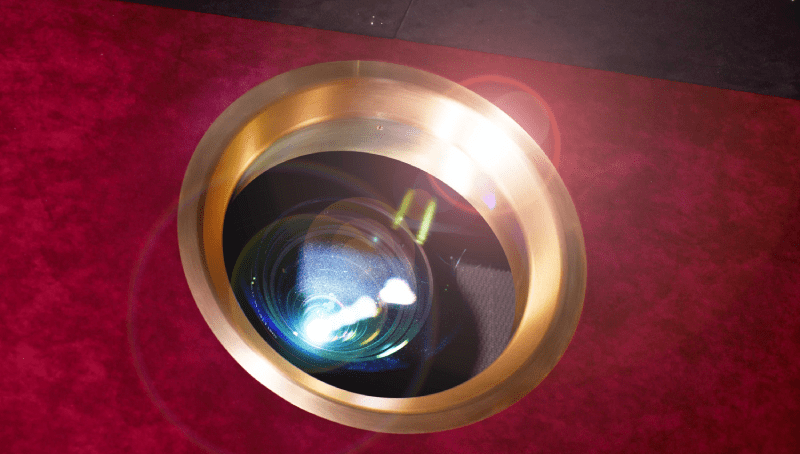
Why was a Trinnov Altitude selected as the processor?
The room presented a significant challenge due to the aesthetic requirements, materials, 3 tiers of seating and construction. However, we were able to overcome these obstacles by using the Trinnov Altitude, which provided us with the necessary 32 channels and interfaced seamlessly with the digital Meridian speakers through the Meridian 271 Controller.
Our objective was to create a system that could deliver more SPL output than what was required, to ensure that we had sufficient headroom for sound fine-tuning without any limitations. The Trinnov Altitude offered us a vast amount of fine-tuning options and bass management, which we believe surpasses other processors in the market.
What technical challenges did you face in achieving the cinema? How were they resolved?
One of the main challenges we faced was the existing HVAC ducting installed around the perimeter of the room which fed other rooms around the property and couldn’t be removed, it also had to be fully isolated to avoid resonance and noise flanking.
Due to the ducting, the height of the front and rear walls was restricted, which, in turn, limited the height of the projector screen in the room. Hence, to achieve the ideal horizontal viewing angles at the Main Listening Position and get the biggest screen possible, we opted for a 2.40:1 ratio screen with side masking (CIH screen).
This screen ratio suited the client's viewing preferences well and allowed us to suggest a Barco projector with a 2.40:1 chip, offering maximum resolution, the client loved the performance of this larger projector; however, it needed more space and a deeper enclosure directly above the third seating row.
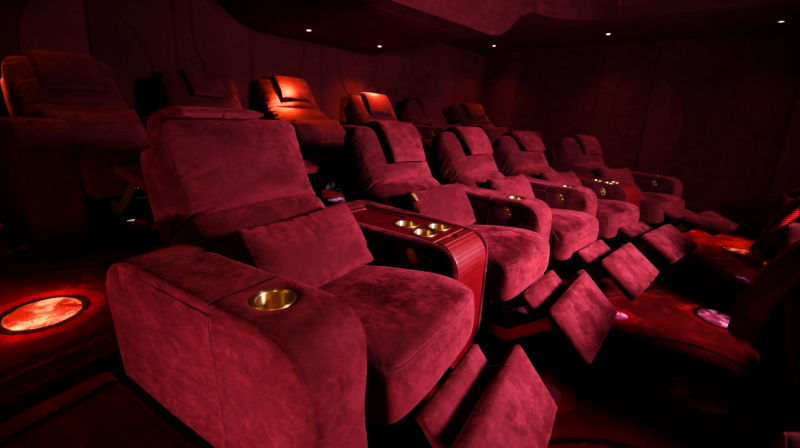
We had to balance between maintaining an unrestricted view from all seating positions, while also ensuring that the head clearance of the ceiling on the rear seating tier was not compromised. Additionally, we had to monitor the projector's laser hazard zone to avoid anyone accidentally looking straight into the lens when walking along the higher tiers.
We were able to achieve the best possible outcome by utilizing intelligent modelling and CAD technology. This resulted in horizontal viewing angles of 39 degrees for the middle row and 54 degrees for the front row, considering all the concerns and requirements. To maintain clear viewing for each row, we raised the screen, and in turn this allowed us to build a stage underneath. The two-tier stage turned out to be perfect for concealing the local game consoles in an active-cooled compartment accessed from the top of the stage.
There was a recess in the side wall at the back of the room which proved perfect for holding the projector enclosure heat management system. Unfortunately, this recess was located exactly where we wanted to position the second row of surround speakers. As a result, we had to move the speakers slightly forward. The advanced speaker settings of the Trinnov allowed us to overcome this limitation.
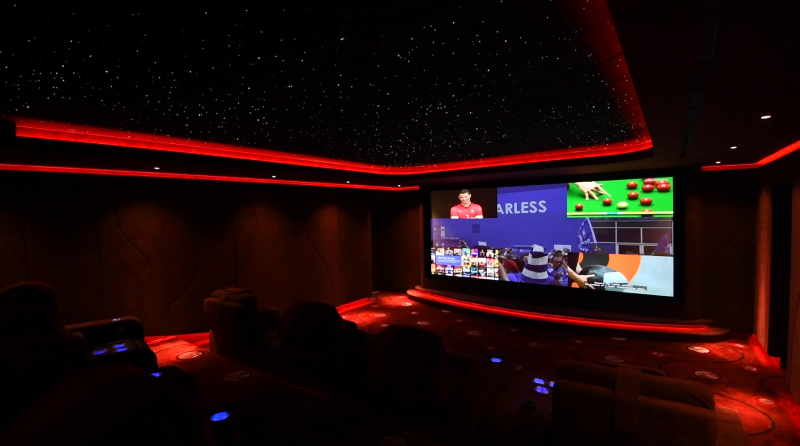
Discuss your experience with the calibration process and the final result achieved with the Optimizer.
We went through multiple stages during the configuration and calibration process. In the first stage, we assigned each speaker to its correct output and carefully tested and set the levels of all speakers. We then moved on to the setup and initial calibration process using the Optimizer. Finally, the experienced ear of Roberto Gamba, a well-known audio calibrator within our industry, was employed to do the final tweaking using Trinnov's advanced settings to get every last detail, clarity, and dynamic out of the system.
What makes this project truly unique – how does it stand apart from other projects?
The construction needed to be of the highest quality, with a meticulous attention to detail. We designed every aspect of the room in CAD, ensuring that the angles and shapes were reflected in different parts of the room. Each section was CNC cut, including the stage, projector ceiling, bespoke Starscape ceiling, wall panels, and supporting structures. We worked closely with the cinema seating company to bespoke the full seating design and layout so it complemented the curve of the tier and steps.
Every detail in the room was custom chosen to create a specific look and performance, including brass cupholders and perforated Alcántara fabric on the walls. We believe that this makes the room unique and instantly recognizable as a distinctively Cyberhomes space.

Tell us a bit about your experience working with Trinnov Audio. Were you assisted by the Trinnov team on this project?
Both the Trinnov and Meridian teams were incredibly helpful in determining the best configuration from the Altitude range to meet the requirements of our project. They also assisted in selecting the optimal speaker positions and helped with the initial setup of the interface between Trinnov and Meridian, which worked exceptionally well.

